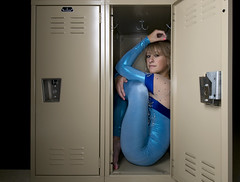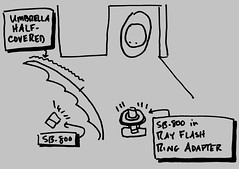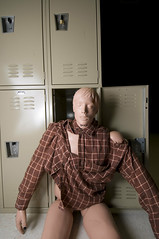 For the final DINFOS post we have flexibility artist Shelly Guy, who was brave enough to venture down into the bowels of the DINFOS photo studio for a series of photos shot by Joe McNally, the 2008 Advanced Lighting Team and myself.
For the final DINFOS post we have flexibility artist Shelly Guy, who was brave enough to venture down into the bowels of the DINFOS photo studio for a series of photos shot by Joe McNally, the 2008 Advanced Lighting Team and myself.As you probably know by now, I generally don't care much for shooting in a studio. Which is why we decided to do a quick change-up on our environment and stuff Shelly in a nearby locker.
But that's no problem -- Shelly can get in there easily. It's getting the light way back in there that can be a bit of a challenge...
___________
So, here's the deal. We do not have a lot of time to shoot in the studio, as the building closes at 9:00 p.m. So Joe and I decided to bounce Shelly back and forth between photographers, with one person setting up with the other one shot.
Shelly was a total trouper, and put up with this sort of thing way better than she should have. (Hey, she has to be flexible. She's a contortionist.)
While Joe was shooting down at the other end of the studio, I was looking for a neat place in which to pose Shelly. How can you turn down a half-sized locker?
Next step is how to light it. I need to get the light all the way to the back. But the last thing I want to do is just blast a bunch of light right in from straight on -- there would be no depth or shape to the photo. You need to light from of axis for shape.
But I have to get in there some way, so I tried to have it both ways on my lighting direction. I decided to light it with an umbrella from camera left, and fill with a ring flash.
By varying my lighting ratio between the two SB-800's (we were totally nuking the ambient away) I could decide exactly how bright the back of the locker (and the parts of Shelly that were in shadow) would be.
My other problem would be that the umbrella needed to be close to provide a nice wrap light. But that would mean that it would reflect off of the locker door on the left and create a big, distracting, umbrella-shaped hot spot.
Problem two was easy to solve. We stuck the black cover on the camera left half of the umbrella. This gobo'd the umbrella from reflecting in the door (save a nice, thin sliver) and still let it light Shelly nice and close.
With the gobo, there is a nice, vertical highlight that defines the texture of the locker door. If the gobo was gone, there would be a big, honker of a circular highlight there.
 So, specular reflection solved, we now needed to push some light into the locker.
So, specular reflection solved, we now needed to push some light into the locker. The Ray Flash ring flash adapter fit the bill perfectly, allowing light that was exactly on axis. This meant that we could not only push as much (or little) light as we wanted back there, but also create a specular highlight in the back of the locker to further brighten that area.
The only thing left to decide is the ratio, really. And this is easy enough, in manual power, without needing a $300 flashmeter.
But first, we needed a stand-in. Fortunately the room contained a mannequin. (Mascot? Late-night companion? Honestly, I don't wanna know...) So naturally, we tried to shove him in there. But the dummy wouldn't fit, so we were S.O.L.
Then I hear, "I can get in there," coming from A.L.T. member Luke Pinneo. (Yeah, right, dude, I thought.) But sure enough, he crammed himself in. No, it was not as elegant as later when Shelly did it, but still...
 So Luke wedges himself into the locker. (All the while, McNally is shooting glamour photos of Shelly, who has no idea what we have in mind for her...)
So Luke wedges himself into the locker. (All the while, McNally is shooting glamour photos of Shelly, who has no idea what we have in mind for her...)I start without the Ray Flash -- just a shoe-mount flash set at 1/64th and aimed up at the ceiling to trip the other flash optically. I bring the umbrella'd SB-800 in from camera left, set on 1/8 power. It's set on slave mode, so the shoe flash will fire it.
A couple of quick pop-n-chimps and we have dialed in the aperture that looks best for the main light. Just doing it by eyeball and histogram on the back screen. Nothing fancy.
Now it is time for the fill light. I slip on the Ray Flash adapter and start out with the flash dialed down to 1/32 power. It's real close to where we want to be, and a couple of quick power adjustments has us ready to go. Again, just turning the volume up or down until it looks best.
Normally, you could also use a flash in an umbrella right behind your camera as on-axis fill. But a light that big would have given you reflection problems on the other door.
I am finding I am going to the ring as fill pretty often these days, and I really like the result. I have a shot like Peter Yang's "Fallon" portrait, with some ring in there, and it looks sweet.
To be honest, I am not a very big fan of ring list as a main light. I think the photos all look the same. But as fill, it can add a neat layer to many different kinds of key lighting.
 So we got Shelly through our portion of the shoot quickly, and back to Joe well before we were to be kicked out. Which left a couple of us a few minutes with nothing to do in the DINFOS studio.
So we got Shelly through our portion of the shoot quickly, and back to Joe well before we were to be kicked out. Which left a couple of us a few minutes with nothing to do in the DINFOS studio.If anyone happens to ask you how this DINFOS studio mascot ended up naked from the waist down and left in a very compromising position at a computer work station, we don't know anything about that.
___________
Related:
:: Shelly Guy, Flexibility Artist ::
:: Ray Flash ring flash adapter ::
:: SB-800 Slave Mode How-To ::
:: McNally's Pix ::




0 comments:
Post a Comment